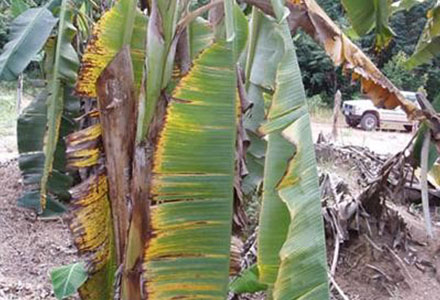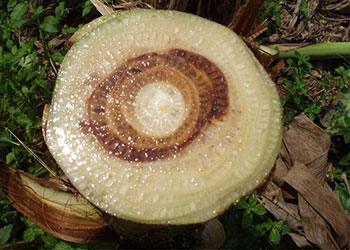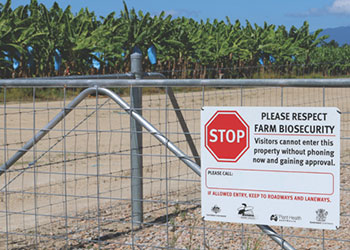PLANT PEST

Dr Luadir Gasparotto, Embrapa, PaDIL.
Panama disease Tropical Race 4
Restricted distribution in Northern Territory and Queensland (under quarantine control)
Features: Soil-borne fungal disease that causes wilting and death in banana
Where it's from: South East Asia, Middle East, southern Africa, Australia (Northern Territory and Queensland)
How it spreads: Movement of infested plants, soil, vehicles, equipment, clothing
At risk: Bananas
Stop the spread
Panama disease is one of the most severe threats facing the banana industry worldwide, with no cure and no banana varieties that are resistant to the disease yet developed. It has been estimated that 80 per cent of global production is under threat from Tropical Race 4.
It is caused by the fungus Fusarium oxysporum f. sp. cubense, which lives in soil and can survive there for many years.
Tropical Race 4 infects Cavendish bananas—Australia’s most grown variety of banana—as well as most other varieties. The fruit of an infected banana plant is not affected by the fungus, and is still safe for human consumption.
Tropical Race 4 was found in Darwin in the 1990s and in Tully in Queensland in 2015. It spreads in plant parts, suckers, soil and water, and can remain in soil for decades, preventing any further banana farming.
If the disease was to spread beyond its current distribution in Australia, or new infections arrive, it could devastate Australia’s banana industry.
Importing goods
To keep any further infections of Panama disease out of Australia, never ignore Australia’s strict biosecurity rules.
Import shipments may need to be treated and certified, so before you import, check our Biosecurity Import Conditions system (BICON).
Visiting banana plantations
Never go into banana plantations without permission. If you need to visit, watch this video on how to protect banana farms.
What to look for
In banana plants look for:
- yellowing of lower or older leaves, caused by the fungus blocking the water conducting tissue within the banana plant stem
- lower leaves collapsing to form a ‘skirt’ around the plant
- cut open, the stem is discoloured from yellow to red, through to dark brown or black, depending on how long the plant has been infected.


Where to look
Importers
Infected banana plants or soil are the most likely way that Panama Disease Tropical Race 4 could once again enter Australia.
Growers and home gardeners
Look for banana plants with yellowing leaves that collapse into a skirt and discoloured stems.
Secure any suspect specimens
If you think you’ve found Panama Tropical Race 4:
- take a photo
- do not disturb infected plants (this may be as simple as closing the doors on a shipping container or preventing access to a part of the plantation).
